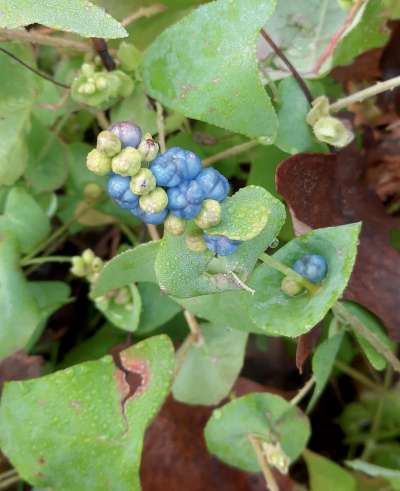
There’s a new invasive in the Northeast, with the potential to spread rapidly in fields and forest clearings. Mile-a-minute weed (Persicaria perfoliata) is an annual vine that lives up to its name by growing up to 6 inches per day. Often called the “kudzu of the North,” a reference to another invasive vine that has devoured the South, mile-a-minute grows on and over native vegetation, smothering the plants and tree seedlings beneath it. In areas with full to partial sun, it can quickly create a monoculture.
Like many other invasives, mile-a-minute is an attractive plant, with tiny white flowers that bloom in spring and metallic blue fruits that appear in July and persist into early autumn. Its distinctive leaves are triangular, with barbs along the leaf veins, on the petioles, and on the stems. The barbs aid the plant in its vertical growth by attaching it to other plants or structures. Smaller, circular leafy structures called ocreae surround the stems at the base of the leaf petiole.
Unfortunately, the fruit is attractive to birds and animals, which spread the seeds in their droppings. These seeds are also buoyant – able to stay afloat for up to nine days – and therefore are well suited to disperse to new sites through moving water. Flooding events can lead to new establishment of this invasive in floodplains.
Native to Asia, mile-a-minute was first experimentally introduced to Oregon in 1890 without becoming established. The first likely established population resulted from a contaminated shipment of plants to a nursery in Pennsylvania during the 1930s. From there, mile-a-minute quickly spread into the Mid-Atlantic states, where it is currently very problematic. It has since spread south to the Carolinas, west to Iowa, and north into New England. There is also an infestation in Oregon.
In New England, the first known infestation was detected in Connecticut in 2000, and the plant showed up in Rhode Island soon thereafter. In Massachusetts, mile-a-minute’s first known appearance occurred in 2006, and the Department of Agricultural Resources has since confirmed 50 infestations throughout the state. The New Hampshire Department of Agriculture reported its first detection of mile-a-minute in 2011 and the department is actively working to eradicate a few other known infestations in the state. Maine’s first infestation occurred in August 2023, when a homeowner found mile-a-minute growing among newly established landscape plants. Vermont also reported its first occurrence of mile-a-minute in October 2023, at a single site in Chittenden County. The most northern reported infestation of mile-a-minute is in New York near Plattsburgh.
Although mile-a-minute dies after a frost, seeds can persist in the soil for up to six years. One method of control is hand pulling, but care must be taken to properly dispose of the vines without spreading the fruit. Repetitive mowing can also be effective if the populations are small. There are pre-emergence herbicides available that can prevent seed emergence and systemic herbicides that can be sprayed on the foliage for control.
Another method to manage mile-a-minute is biocontrol. The mile-a-minute weevil (Rhinocomimus latipes) is a tiny beetle from China that feeds exclusively on its host plant – it is not a risk to other plants – and can be used to provide control. Adult weevils are initially black but their bodies turn orange as they feed on mile-a-minute leaves. The beetles feed and mate in spring and lay their eggs on the leaves and stems of the plant. When the larvae hatch, they burrow into the stems, where they feed and grow during the summer months. This feeding disrupts the flow of water and nutrients within the plant. Once larvae are fully developed, they drop to the soil to pupate and overwinter as adults. The feeding by adults also weakens the plant. A 2022 study by the Connecticut Agricultural Experiment Station found that the weevils negatively impacted the growth of mile-a-minute and delayed fruit production at some sites.
Mile-a-minute weevil has been released in numerous states as a biocontrol agent. The first weevil releases in New England occurred in Connecticut in 2009. The weevils are now considered established in the state, with more than 60,000 released to date. Weevils have also been released in Massachusetts and Rhode Island.
While it’s too early to tell if the weevils will stop the invasion of mile-a-minute, their documented impact on the plant offers some hope for future management. As with all new invasive species, however, the best defense is early detection and rapid reporting. You can help slow the spread of mile-a-minute by reporting sightings to your local county extension office or state department of agriculture.

